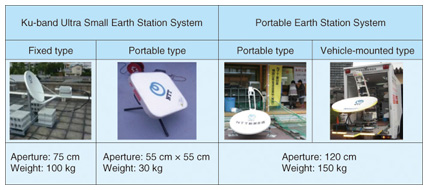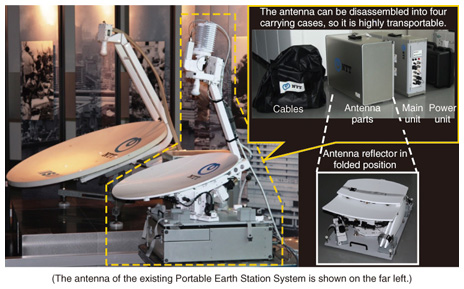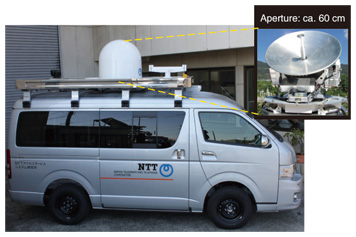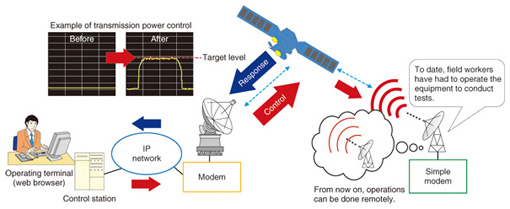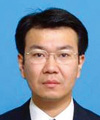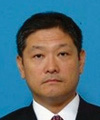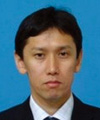 |
|||||||||
|
|
|||||||||
|
Regular Articles Vol. 10, No. 7, pp. 26–30, July 2012. https://doi.org/10.53829/ntr201207ra2 Small Satellite Earth Stations for Disaster Recover OperationsAbstractNTT Access Network Service Systems Laboratories has developed small satellite earth stations for satellite communications to provide communication links for specially installed public phones and Internet connection in evacuation and disaster response centers in the event of communications being disrupted by disasters and other emergencies. These earth stations are compact and lightweight and use antenna reflectors that can be dismantled and reassembled, so that they can be packed inside carrying cases. They are equipped with automatic satellite-capture and -tracking functions and with functions for remotely conducting uplink access tests, which enable rapid link provisioning and reduce the setup operations that must be done by field workers.
1. IntroductionBecause of the wide coverage and ease with which link provisioning can be carried out with satellite communication systems, they are useful in serving as communications systems for disaster recovery operations. As part of the NTT Group’s protocols for restoring the communications infrastructure in the event of a disaster, temporary communication links are initially secured in evacuation and disaster response centers through satellite communications systems while efforts to restore optical fiber and other transmission lines are underway. The satellite earth station systems currently used by NTT EAST and NTT WEST for disaster response operations [1] are shown in Fig. 1. The Ku-band Ultra Small Earth Station System provides one audio line per channel, while the Portable Earth Station System utilizes voice over Internet protocol (VoIP) for voice communications, simultaneously providing multiple lines for both voice and IP data transmission.
However, since these systems were built more than fifteen years ago, they are now showing signs of deterioration, and it has become difficult to purchase brand new equipment and repair damaged equipment. Moreover, their setup involves manual tasks such as manual alignment of the antenna to the satellite direction, so installation takes at least one hour even when performed by experienced engineers. Furthermore, since they are not very easy to transport, they offer poor mobility and setup speed, which are essential factors in disaster recovery operations. To overcome these problems, NTT Access Network Service Systems Laboratories has developed the Small Satellite Earth Station [2], [3]. 2. Summary of development processThe goal of the development was to make use of current portable satellite systems without making any major changes to them. To achieve this, we developed three new devices for the earth station terminal and a new program for the control station. Two kinds of antennas were developed to provide a choice of two terminal compositions according to the situation of a stricken area, i.e., a flyaway type station and a vehicle-mounted type station. The flyaway type is easy to carry to a disaster area because it can be broken down and packed into four separate carrying cases. On the other hand, the vehicle type can be installed on a normal-sized car, so it can reach a stricken area quickly to help restore communications. Both terminals can start performing their mission in less than approximately 15 minutes owing to the satellite auto-tracking function compared with 60 minutes at present. These stations ensure a transmission speed of up to 384 kbits/s for the return link, which can carry ten VoIP channels, simultaneously. The technologies that we developed are summarized in sections 2.1–2.4. 2.1 Flyaway antennaThe flyaway antenna that we have developed for the earth station is shown in Fig. 2. This antenna can be readily carried by hand to disaster areas that are inaccessible by car or other means of transportation. We chose to use a 75-cm-aperture reflector antenna that can be dismantled and reassembled to enable transportation inside a carrying case. Other parts can also fit into cases, which greatly increases the portability compared with the existing device. Moreover, no tools are needed for disassembly, packing, and reassembly and the automatic satellite-capture function removes the need for operators to have special skills to set it up: setup can be finished within approximately 15 minutes.
2.2 Vehicle-mounted antennaThe vehicle-mounted antenna that we have developed for the earth station is shown in Fig. 3. This antenna is mounted on the roof of a vehicle and is suitable for use in disaster areas that are still accessible by vehicles. The antenna aperture was reduced to approximately 60 cm to enable mounting on even ordinary cars. In addition to an automatic satellite-capture function, it also has a function for automatically tracking satellites while the vehicle is moving. Antennas of this type are widely used in ships, but ours is considerably simplified, making it lighter in weight, lower in height, and less costly.
2.3 Simple modemThe simple modem that we have developed for the earth station is shown in Fig. 4. If a disaster affects a wide area, a large number of earth stations will need to be installed. However, there is a limit to the frequency range that can be used for satellite communications. Thus, to enable simultaneous use in as many places as possible, we have developed a modem with limited communication speed and frequency band for each earth station. In addition, using the same transmission system as that of existing portable satellite communication systems enables operations with only minimal changes to the current configuration and settings of base stations of existing portable satellite systems. By removing unnecessary functions and reducing the capacity to the minimum necessary, we were able to reduce the weight to one-fourth and the size to one-half of the current modem.
2.4 Remote uplink access test programIn existing systems, an uplink access test is carried out after the earth stations have been installed but before they begin operations. This test is conducted through phone conversations between technicians of SKY Perfect JSAT Corporation, the owner and operator of the satellites, and field workers to check that the antenna direction and power transmission levels are correct. Thus, in order to conduct these tests, the field workers require knowledge and skills of radio communication systems. However, during widespread disasters, such as the Great East Japan Earthquake of 2011, it is difficult to easily gather many field workers who have such knowledge. To enable field workers who do not have such knowledge to easily set up earth stations in the field, NTT Access Network Service Systems Laboratories has developed an uplink access test program that can be operated remotely from a control station. The procedure for conducting this test remotely using this program is shown in Fig. 5.
3. ConclusionThe small satellite earth stations can provide a communications infrastructure quickly in the event of a disaster-induced communications disruption. These systems are scheduled for deployment in NTT EAST and NTT WEST during the current fiscal year (FY2012). NTT Access Network Service Systems Laboratories will continue to conduct research and development of technologies that can compensate for the speed and performance limitations arising from the conversion of earth stations into small lightweight systems. To enable a faster disaster response and improved user-friendliness, we will continue to improve the functionality and performance of these systems through a flexible combination of such technologies according to experience gained during disasters. References
|
|||||||||









